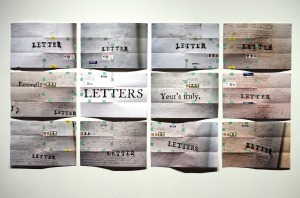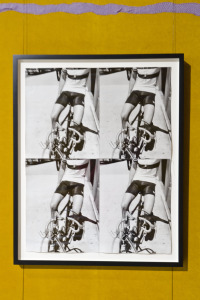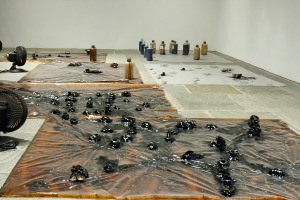The Whitney Biennial 2012 (New York City: March 1 to May 27, 2012)

Transparency, Institutional Critique and Performance Art dominate the 2012 Whitney Biennial. The curators of the Biennial attempt to take the pulse of the most current trends in American Art and put the snapshot on display in five floors of the Whitney Museum’s viewing space in New York City.
Transparency is an art movement that continues to dominate American art. In many of the pieces, the overt display of the artists’ materials and method of creation are visible. Even the oil paintings by Andrew Masullo show the artists selection of oil paint through the use of bold colors and heavy brushes. Unlike the fast drying acrylic, the oil paint takes time to dry before the next color can be applied.
Moyra Davey’s Mary, Marie tells a story with photographs that are sent through the mail. For her, the photograph is not something to be mounted and preserved, but something that can be folded, stamped and sent through the mail to tell a story. The medium of photography in our multimedia age replaces the letters of ink on paper and conveys the story through pixels instead of letters. The subject of her photography in this piece is the word, “letter.”

Institutional Critique is a conceptual movement in art that refers to the art institution as a space for presenting art that has a point of view. The space is not neutral. The art exists in the context of the museum space where it is displayed and it is experienced this way. The institution organizes and displays the art that we experience and by so doing the institution defines the Art.
Much of the work the Whitney selected shows how much the distinction between artist and curator continues to diminish. This trend in art began in the 1990’s and the Biennial pushes it to a new level with the artist almost going beyond curator toward the role of collector.
Nick Mauss’s installation, Material Studies 2008-11, perfectly illustrates this role of curator/artist. He created two doors that lead from the elevator through a passageway of velvet. A lesser known piece by Andy Warhol selected from the Whitney’s collection hangs on the passageway wall. From there, it opens to the gallery space, but the first works you see are from the Whitney’s collection cureted by Nick Mauss.
Perhaps the most surprising feature of this year’s Biennial is the dominance of Performance Art. Over 4,000 sq. ft of the fourth floor became a makeshift movie theater for SaraMichelson’s, Devotion Study #1—The American Dancer, showing a ballet on large multi-panel screens. While Sara Michelson conceived the piece and created the experience, the performers, musicians and film crew are artists as well. In this piece Michelson is both artist and curator.
Werner Herzog’s Hearsay of the Soul uses the work of Hercules Segers, a lesser known artist and sets it to music. The music is by Ernst Reijseger. At times the musicians or their instruments appear on one or more of the 6 panels in the installation. This piece brings together Transparency and Performance Art strung together to complete the vision of the artist as curator.
After wandering through five floors of great new art, it is the curators’ choice of Sam Lewitt’s work, Fluid Employment, more than any other that defines the 2012 Whitney Biennial. Lewitt uses ferrofluid, a compound developed in the 1960’s by NASA. Ferrofluid is used in loudspeakers and consumer electronics but it is also used in guided missiles and weapons of mass destruction. Lewitt’s exhibit places magnets in the ferrofluid which causes it to form small sculptures. Fans speed the fluid’s evaporation. Lewittt needs to replace the ferrofluid once every two weeks. By doing so, he becomes the performer, the curator and the artist. He displays the tools and method of creation and defines the space where we observe and experience it.
This is the 76th Whitney Biennial and the last one to be held in the 74th Street, Madison Avenue museum. The next Biennial will be displayed in the Whitney’s new location on 14th Street.


